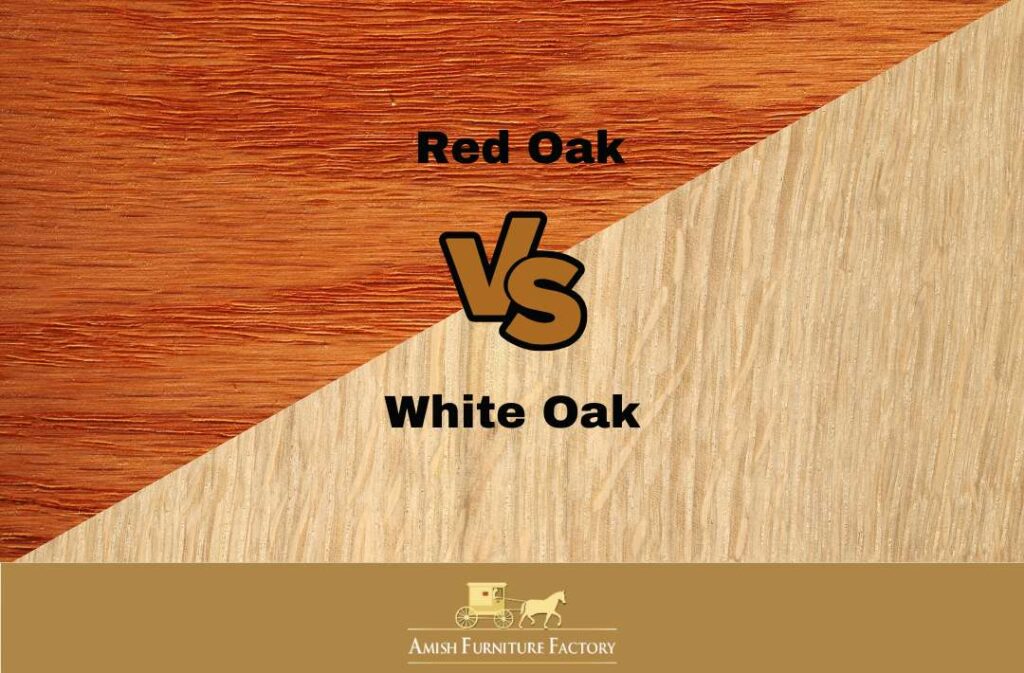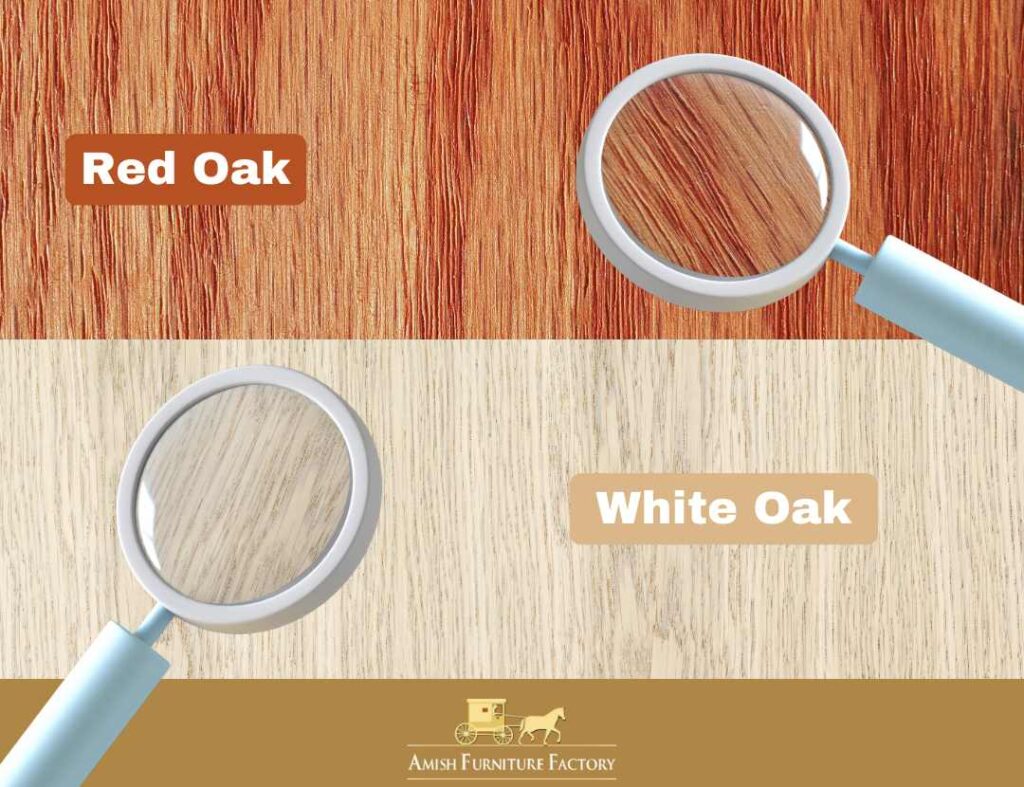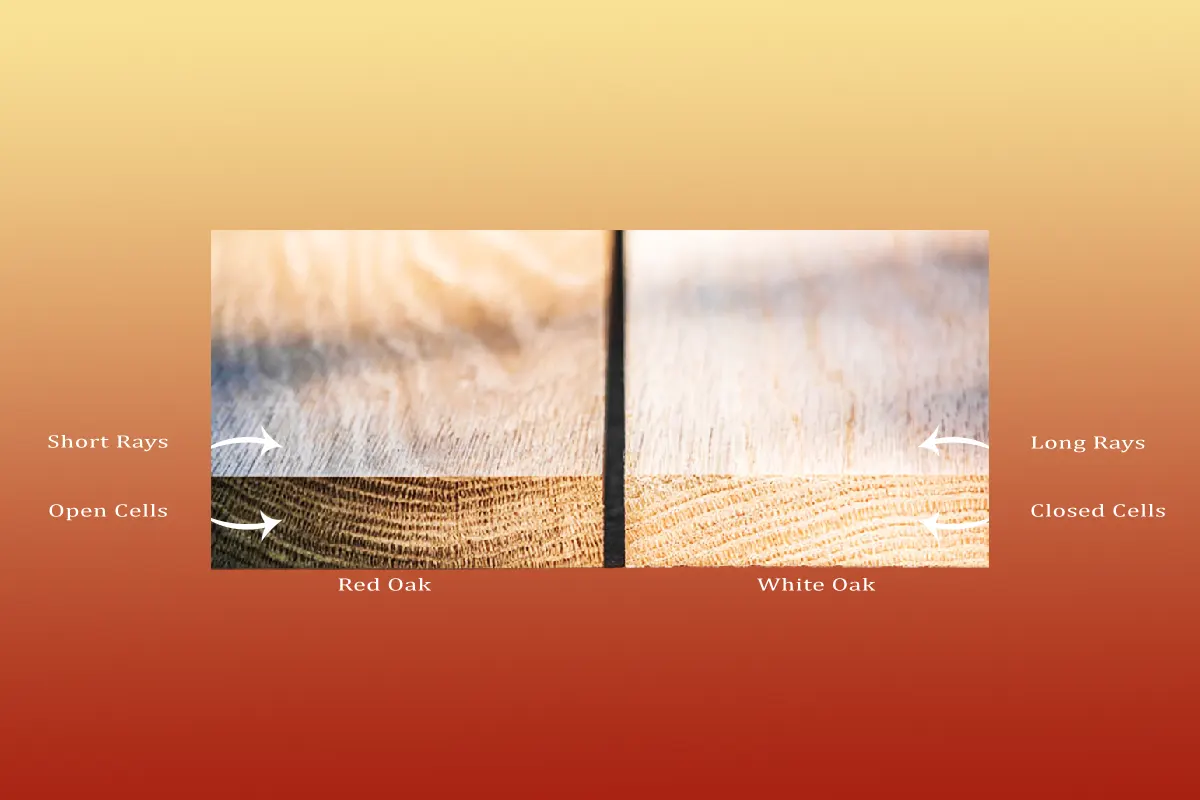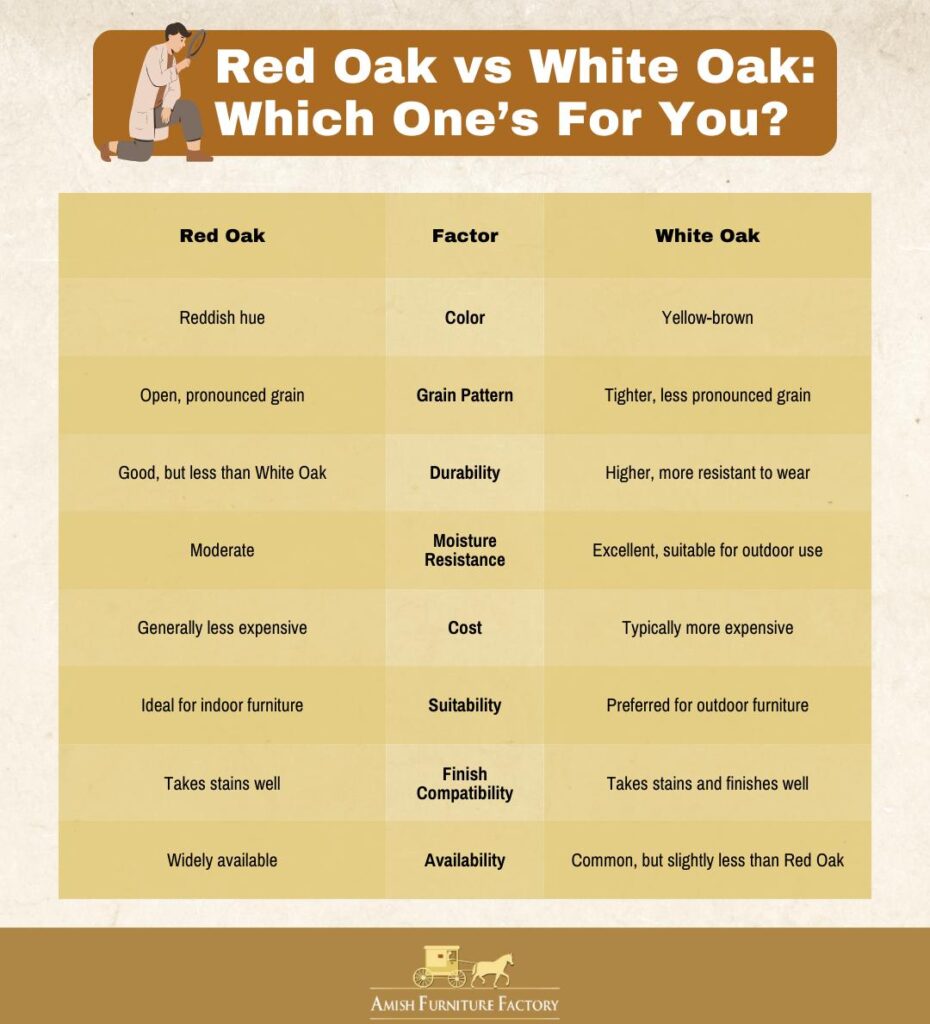
Whether it’s used for furniture or flooring, oak is generally broken down into one of two different categories — red and white oak. While they are both excellent hardwood choices in terms of beauty, there are some notable differences between them.
Red oak is distinguished by its reddish hue and open grain, whereas white oak is more yellow-brown with a tighter grain and offers greater durability and moisture resistance. These differences affect their suitability for various applications and impact their cost.
Curious about how these differences play out in real-world applications? Read on to delve deeper into the historical contexts, physical characteristics, and practical applications of red and white oak.
Red Oak vs White Oak: An Overview
Quercus rubra, or red oak, is a member of the broad group of red oaks consisting of shingle, blackjack, black, northern pin, and pin. The average tree size is 60-70 ft tall, and the average dried weight is 700 kg/m3.
Red oak trees are native to North America. They are frequently seen in parks and gardens as ornamental trees.
On the other hand, Quercus alba, or white oak, grows up to 60-100 ft tall. White oak trees thriving in a forest are usually more extensive than those planted in any open area that grow to be smaller yet massive. Its average dried weight is 755 kg/m3.
White oak trees are native to eastern and central North America. They are usually found in Minnesota, southern Maine, east Texas, and northern Florida. You can also see these trees in some cities in Canada, like Quebec and Ontario.
Red and White Oak in History

Oak has stood the test of time, serving as a cornerstone in the field of construction and furniture making. When you take a closer look into the history of red and white oak, you’re not just exploring different types of wood, but you’re uncovering a story that’s deeply intertwined with human civilization.
Red and white oak have a storied past, marked by their significant roles in building societies. For centuries, these woods have been a top choice for everything from shipbuilding to architecture. If you’re a history buff, you’ll appreciate knowing that red oak was widely used in barn construction across America, while white oak played a crucial role in shipbuilding, thanks to its water-resistant properties.
Fast forward to today, and these oaks still carry their historical legacy. While their uses have evolved, the appreciation for their strength and beauty remains constant. Next time you see an antique oak piece, remember, it’s not just a piece of furniture; it’s a slice of history.
Modern Uses: How Red and White Oak Fit into Today’s World
In contemporary times, red and white oak continue to be highly sought after, but for different reasons. If you’re into DIY projects or professional woodworking, you’ll find red oak appealing for its workability and affordability. It’s a common sight in home interiors, from flooring to cabinets, offering a warm, inviting aesthetic.
White oak, on the other hand, has carved its niche in outdoor applications and fine furniture. Its resistance to moisture makes it a top pick for outdoor settings and even boatbuilding. So, whether you’re planning a new deck or a heirloom-quality dining table, white oak might be your go-to.
Physical Characteristics
When choosing between red and white oak, it’s essential to understand their physical differences. These characteristics not only affect the wood’s appearance but also its suitability for various applications. Let’s dive into the color variations, grain patterns, and textures that set these two types of oak apart.
Color Variations: Exploring the Shades of Red and White Oak
The color of the wood can significantly influence the overall look and feel of your project. Red oak, as you might guess from its name, has a natural reddish-brown hue that radiates warmth. This coloration can bring a cozy and traditional ambiance to your living spaces.
In contrast, white oak features a more subtle yellow-brown color, often with a hint of a grayish tone. This cooler color palette makes white oak a favorite for contemporary designs. It can create a more modern and sophisticated atmosphere in your home or outdoor space.
Analyzing Grain Patterns: A Comparison of Red and White Oak

Grain pattern is another critical factor in wood selection, especially if you’re aiming for a particular aesthetic. Red oak is known for its open grain pattern, which is more pronounced and can add a lot of character to your projects. This pattern is particularly striking when stained, making red oak a popular choice for statement pieces.
White oak, in contrast, offers a straighter, more uniform grain pattern. Its subtle, less dramatic grain makes it ideal for projects where you prefer a smoother, more consistent look. The difference in grain patterns between red and white oak is not just a matter of aesthetics but also affects how the wood absorbs stain and finishes.
Texture in Red vs. White Oak
Texture plays a crucial role in how wood feels to the touch and how it looks under different lighting conditions. White oak, known for its smoother texture due to smaller pores, offers a refined finish that’s pleasing both visually and tactilely. It’s an excellent choice for high-end furniture or surfaces where a smooth touch is desired.
Red oak, with its larger pores, has a more pronounced texture. This characteristic gives it a distinct feel that can be quite appealing, especially in rustic or traditional settings. When you run your hand over a piece of red oak, you’ll notice the difference immediately, adding another layer of sensory experience to your projects.
Durability and Hardness
Understanding the durability and hardness of red and white oak is vital for your projects, especially if you’re a prepper or someone who values long-lasting materials. These qualities determine how well the wood withstands daily wear and tear, a crucial factor for both functional and aesthetic longevity.
Measuring Strength: Janka Ratings of Red and White Oak
The Janka hardness rating is a standard measure of wood’s resistance to denting and wear. White oak boasts a Janka rating of 1360, slightly higher than red oak’s 1290. This difference might seem small, but it can be significant depending on your project’s needs.
For you, this means white oak is slightly tougher and better suited for high-traffic areas or outdoor use where durability is key. If you’re considering flooring, for example, this information could be the deciding factor between these two types of wood.
Practical Durability: Choosing Oak Based on Hardness and Resistance
Regarding practical applications, the slightly higher hardness of white oak translates into better resistance to scratches and dents. This makes it an excellent choice for areas like kitchen floors or dining room tables, where durability is a priority.
Red oak, while slightly softer, still offers good durability and is often preferred for indoor furnishings. Its resilience makes it suitable for everyday items like bookshelves and cabinets, especially in areas where the traffic is moderate. Understanding these nuances in durability can help you make informed decisions for your long-term projects.
Moisture Resistance and Applications
The ability of wood to resist moisture is a critical factor, particularly if you’re working on projects that might be exposed to the elements or require water resistance. Both red and white oak have unique characteristics in this regard, impacting their suitability for various applications.
White Oak in Wet Environments
White oak’s superior water resistance is one of its standout features. This quality is due to its cellular structure, which includes tyloses that block water and air, making it nearly waterproof. It’s no wonder white oak has been the wood of choice for boatbuilding and outdoor furniture.
For you, this means if you’re planning projects like garden planters, outdoor decks, or even barrels for wine or whiskey, white oak is your ideal candidate. Its ability to withstand moisture without rotting or warping gives it a clear advantage in wet environments.
Red Oak’s Moisture Limitations
Red oak, while not as moisture-resistant as white oak, holds its own in interior applications. Its slightly more porous nature makes it less suitable for outdoor use or where water exposure is likely. However, this doesn’t diminish its value for indoor projects.
In your home, red oak can be an excellent choice for areas like flooring or trim. Red oak furniture also has its warm tones and distinctive grain that really shines. Just be mindful of using it in places like bathrooms or kitchens, where moisture is more prevalent. With proper sealing and care, red oak can still be a beautiful and functional choice for many indoor applications.
Staining and Finishing

As we move into the topic of staining and finishing, the distinctions between red and white oak become even more pronounced. These steps are crucial in highlighting the natural beauty of the wood, and understanding how each type of oak responds to them can be a game-changer for your projects. Let’s explore how red and white oak interact with stains and finishes, and what that means for the final look of your work.
Absorption Differences in Red and White Oak
When you apply stain to wood, you’re not just changing its color; you’re accentuating its natural features. Red oak, with its open-grain structure, tends to absorb stains more evenly. This characteristic can be a blessing if you’re aiming for a uniform color, as it allows the stain to penetrate deeply and evenly, resulting in a consistent finish.
White oak, however, behaves differently due to its tighter grain and smaller pores. It can sometimes absorb stain unevenly, leading to a more varied coloration. While this can add character and depth to the wood, it’s something to be mindful of if you’re looking for a uniform appearance. This variance can be particularly noticeable with darker stains.
Visual Impact: How Stains Transform Red and White Oak
The impact of staining on red and white oak isn’t just about color; it’s about bringing out the wood’s inherent beauty. On red oak, stains tend to highlight the wood’s natural red and pink undertones, making it a great choice if you want a warm, rich color palette. This can add a cozy, inviting feel to any space.
White oak, with its cooler undertones, offers a more subtle and sophisticated look when stained. Stains can bring out the complexity of its grain, enhancing the wood’s natural elegance. This makes white oak an excellent choice for modern, minimalist designs where the focus is on clean lines and understated beauty.
Cost Comparison

The cost of wood can significantly influence your choice, especially if you’re working within a budget. Understanding the price differences between red and white oak, and what drives these differences, is essential.
When it comes to affordability, red oak generally has the upper hand. It’s typically less expensive than white oak, primarily due to its greater availability. This cost difference can be a deciding factor, especially for large projects where the budget is a major consideration.
For you, this means if you’re looking for a cost-effective option without compromising on quality, red oak might be the way to go. Its lower price point, combined with its attractive appearance and workability, makes it a popular choice for a wide range of applications.
Factors Affecting Oak Wood Costs
Several factors influence the cost of red and white oak wood. The availability of the wood is a major factor; red oak is more abundant in the market, which usually translates to a lower price. On the other hand, white oak’s relative scarcity and higher demand, especially for certain applications like boatbuilding, can drive up its price.
Other factors include the size and quality of the lumber, transportation costs, and market demand. So, when you’re comparing prices, remember to consider these variables. They can significantly impact the overall cost of your project.
Environmental Impact
Sustainability is a key factor in choosing materials, and both red and white oak score well in this area. These species are native to North America and are managed and harvested under strict guidelines to ensure their populations remain healthy. This means when you choose either red or white oak, you’re making a choice that supports sustainable forestry practices.
Moreover, both types of oak have a relatively low carbon footprint compared to other building materials like plastics or metals. This makes them a more environmentally friendly option for your projects. Plus, their durability means they won’t need to be replaced as frequently, reducing waste over time.
The Role of Oak in Eco-Friendly Woodworking
Oak’s role as a renewable resource is a big plus for eco-conscious woodworkers. Both red and white oak grow relatively quickly and are replanted and managed responsibly. This ensures a continuous supply without depleting natural forests.
Additionally, the use of oak in woodworking contributes to carbon sequestration. As these trees grow, they absorb carbon dioxide from the atmosphere, storing carbon in the wood. By choosing oak for your projects, you’re not just creating something beautiful; you’re also contributing to a healthier planet.
Special Considerations for Choosing Between Red and White Oak
Selecting the right type of oak for your project is more than just a matter of taste; it’s about understanding each wood’s unique properties and how they align with your needs. Whether you’re a prepper, a professional woodworker, or a DIY enthusiast, considering these factors will help you make an informed decision.

Aesthetic Considerations in Oak Selection
Aesthetics play a huge role in wood selection. If you’re drawn to warm, rich tones, red oak, with its vibrant hues and prominent grain, might be your choice. Its classic look is ideal for traditional or rustic designs, where the wood’s character can truly shine.
If you prefer a more refined, understated appearance, white oak might be more your style. Its subtle grain and cooler color palette lend themselves well to contemporary and minimalist designs. The choice between red and white oak often comes down to personal preference and the overall aesthetic you aim for in your project.
Tips for Selecting the Perfect Oak
When selecting the perfect oak for your project, consider the wood’s final application. For areas exposed to moisture or the outdoors, white oak’s superior moisture resistance makes it a better choice. For indoor furniture or cabinets where warmth and character are desired, red oak can be an excellent option.
Also, think about the wood’s workability and its interaction with stains and finishes. Red oak is generally easier to work with and stains more evenly, while white oak requires a bit more finesse but offers a unique, sophisticated finish. Weighing these factors will help you choose the oak that not only looks good but also performs well in your intended application.
Final Thoughts
Choosing between red and white oak is more than just picking a type of wood; it’s about understanding their unique characteristics and how they align with your project’s requirements. Whether you’re drawn to the warm tones of red oak or the refined elegance of white oak, each has its place in woodworking and construction.
By considering their historical significance, physical characteristics, durability, moisture resistance, staining and finishing qualities, cost, environmental impact, and special considerations, you’re equipped to make an informed decision. Remember, the right choice of oak can elevate your project from good to extraordinary.
